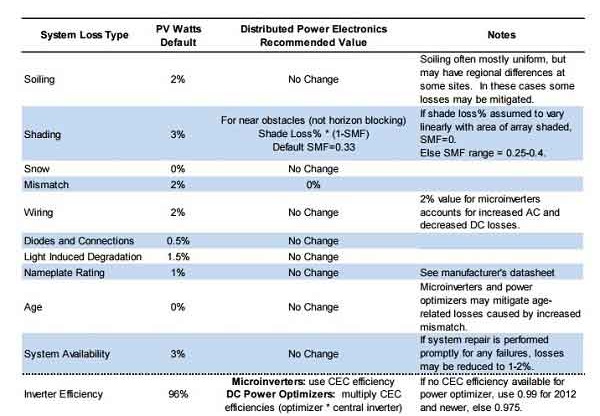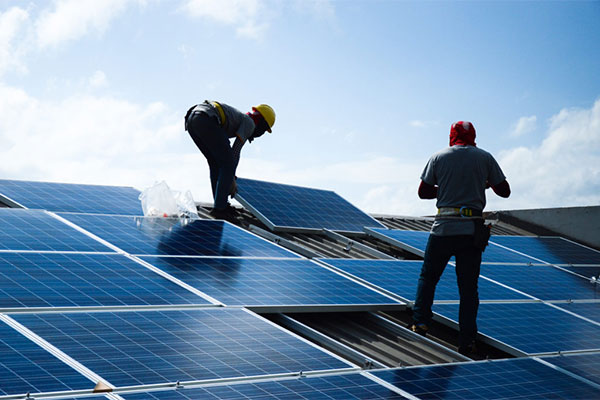NREL’s PVWatts calculator performs simplified PV system performance calculations using information about the array’s geographic location, orientation and a set of user-input loss factors.
PVWatts’ default values and recommendations for these loss factors are designed for a PV system with a central inverter, and do not account for use of microinverters or DC power optimizers. The following sections provide guidelines for choosing reasonable values to use in PVWatts to model systems with microinverter.
While all of PVWatts’ loss factors can be tailored to represent individual system characteristics, a subset are particularly affected by use of distributed power electronics. Note that this document specifically addresses system losses used in PVWatts Version 5, which was updated in September 2014 and has changed slightly from previous versions of the tool.
Inverter: Version 5 of PVWatts allows the user to enter a nominal inverter efficiency. For microinverters, this factor should simply be the California Energy Commission (CEC) weighted efficiency; this is no different from a system with a central or string inverter. Efficiency is assumed to include the device’s effectiveness of maximum power point tracking.
Mismatch: All module level power electronics are expected to eliminate mismatch losses caused by performance variation between modules. This loss factor should be 0% for all distributed electronics technologies.
Wiring: In a PV system with microinverters, DC wiring losses are effectively eliminated. However, AC wiring losses will increase since there are more and longer AC wiring routes. A recommended guideline for the wiring loss term is 2% for the entire system.
System Availability: Due to improved system monitoring capabilities, distributed power electronics may decrease PV system downtime, with published reports indicating that there may be potential to increase availability by a total of 1 to 2%. While module-level conversion mitigates losses associated with point failures in a PV system, it may also result in longer time to fix these failures, as their individual impact on system performance may be too small to justify the expense of service calls. Without concrete evidence to support increased PV system availability, it is recommended that this category of losses remain unchanged, particularly if PVWatts is being used to model the first year of a PV system’s operation when equipment failures are less likely.
Shading: Microinverters have the potential to recover some of the power that is lost in partially shaded PV systems with central inverters, when obstacles block the sun’s incident beam radiation. The fraction of the losses recovered are referred to as the Shade Mitigation Factor (SMF). This value represents the annual percentage of shading losses that can be recovered through the use of distributed electronics in partially shaded PV systems. The SMF can be used to calculate an updated shade loss term by the following equation:
Shade Loss (new) = Shade Loss % ∗ (1 − SMF)
Independent research indicates that a reasonable range for distributed electronics’ SMF is 0.25 to 0.4, with an individual array’s SMF depending on shade distribution and extent, as well as the array configuration. The shade benefit of distributed electronics can vary with the size of the PV system, and the type of shading. A default SMF value of 0.33 is recommended here as an average value.
Soiling: Soiling is generally uniform on PV systems, so it is not anticipated that distributed power electronics would appreciably affect most arrays’ soiling losses. However, in very large arrays with regional soiling differences, or in arrays made up of modules with different orientations or tilts from one another, there may be an opportunity for some fraction of the losses to be mitigated, similar in form to the Shade Mitigation Factor.
PVWatts System Losses and Inverter Efficiency
 Table 1. Recommended PV Watts System Losses and Inverter Efficiency with Microinverters or
Table 1. Recommended PV Watts System Losses and Inverter Efficiency with Microinverters or
Power Optimizers
Editor’s Note:
NREL is a national laboratory of the U.S. Department of Energy Office of Energy Efficiency & Renewable Energy Operated by the Alliance for Sustainable Energy, LLC
This report is available at no cost from the National Renewable Energy Laboratory (NREL) here.
















Comments